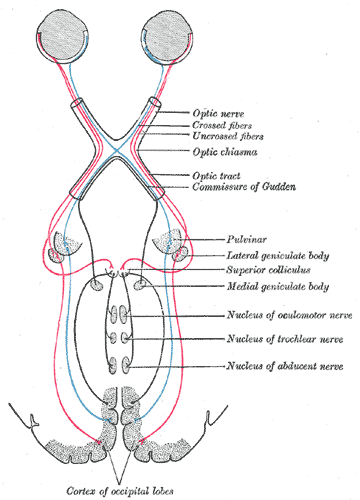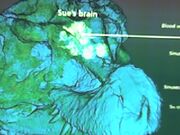Assessment |
Biopsychology |
Comparative |
Cognitive |
Developmental |
Language |
Individual differences |
Personality |
Philosophy |
Social |
Methods |
Statistics |
Clinical |
Educational |
Industrial |
Professional items |
World psychology |
Biological: Behavioural genetics · Evolutionary psychology · Neuroanatomy · Neurochemistry · Neuroendocrinology · Neuroscience · Psychoneuroimmunology · Physiological Psychology · Psychopharmacology (Index, Outline)

Typical sensory system: the visual system, illustrated by the classic Gray's FIG. 722– This scheme shows the flow of information from the eyes to the central connections of the optic nerves and optic tracts, to the visual cortex. Area V1 is the region of the brain which is engaged in vision.
A sensory system is a part of the nervous system responsible for processing sensory information. A sensory system consists of sensory receptors, neural pathways, and parts of the brain involved in sensory perception. Commonly recognized sensory systems are those for vision, hearing, somatic sensation (touch), taste and olfaction (smell).
Sensory systems code for four aspects of a stimulus; type (modality), intensity, location, and duration. Certain receptors are sensitive to certain types of stimuli (for example, different mechanoreceptors respond best to different kinds of touch stimuli, like sharp or blunt objects). Receptors send impulses in certain patterns to send information about the intensity of a stimulus (for example, how loud a sound is). The location of the receptor that is stimulated gives the brain information about the location of the stimulus (for example, stimulating a mechanoreceptor in a finger will send information to the brain about that finger). The duration of the stimulus (how long it lasts) is conveyed by firing patterns of receptors.
Receptive fields have been identified for the visual system, auditory system and somatosensory system, so far.
Modality[]
There are many stimulus modalities: temperature, taste, sound, and pressure. The type of sensory receptor activated by a stimulus plays the primary role in coding the stimulus modality.
In the memory-prediction framework, Jeff Hawkins mentions a correspondence between the six layers of the cerebral cortex and the six layers of the optic tract of the visual system. The primary visual cortex has areas labelled V1, V2, V3, V4, V5, MT, IT, etc. Thus Area V1 mentioned below, is meant to signify only one class of cells in the brain, for which there can be many other cells which are also engaged in vision.
Hawkins then lays out a scheme for the analogous modalities of the sensory system. Note that there can be many types of senses, some not mentioned here. In particular, for humans, there will be cells which can be labelled as belonging to V1, V2 A1, A2, etc.:
V1 (vision)[]
Visual Area 1, or V1, is used for vision, via the visual system to the primary visual cortex. See the illustration above.
A1 (auditory - hearing)[]
Auditory Area 1, or A1, is for hearing, via the auditory system, the primary auditory cortex.
S1 (somatosensory - touch)[]
Somatosensory Area 1, or S1, is for touch and proprioception in the somatosensory system. The somatosensory system feeds the Brodmann Areas 3, 1 and 2 of the primary somatosensory cortex. But there are also pathways for proprioception (via the cerebellum), and motor control (via Brodmann area 4).
G1 (gustatory - taste)[]
Gustatory Area 1, or G1, is used for taste.
O1 (olfactory - smell)[]

The olfactory bulbs are the most highly developed part of this Tyrannosaurus rex's brain.
Olfactory Area 1, or O1, is used for smell. In contrast to vision and hearing, the olfactory bulbs are not cross-hemispheric; the right bulb connects to the right hemisphere and the left bulb connects to the left hemisphere.
Human sensory system[]
The Human sensory system consists of the following sub-systems:
- Visual system consists of the photoreceptors, optic nerve, and V1.
- Auditory system
- Somatosensory system consists of the receptors, transmitters (pathways) leading to S1, and S1 that experiences the sensations labelled as touch or pressure, temperature (warm or cold), pain (including itch and tickle), and the sensations of muscle movement and joint position including posture, movement, and facial expression (collectively also called proprioception).
- Gustatory system
- Olfactory system
Human sensory receptors are:
| Nervous system - Sensory system - edit |
|---|
| Special senses: Visual system | Auditory system | Olfactory system | Gustatory system Somatosensory system: Nociception | Thermoreception | Vestibular system | Mechanoreception (Pressure, Vibration & Proprioception) | Equilibrioception |
de:Sinnesorgan es:Sistema sensorial fr:Système sensoriel is:Athygli lt:Jutimo organai sl:Čutilo
| This page uses Creative Commons Licensed content from Wikipedia (view authors). |